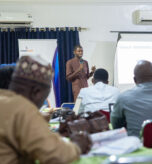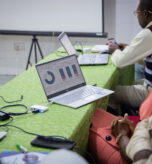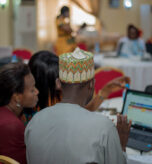In our interconnected world, international development has become a critical driver of global progress. It encompasses sustainable economic growth, social progress, and environmental protection, all aimed at improving the well-being of humanity. Nations in a bid to create a better world for everyone, have over the past century continued to redefine their priorities and principles to uphold equity, equality, inclusion, and social justice for all. Thus, the field of international development is constantly evolving as it shapes the course of our collective future [1].
As sustainable development continues to advance equal opportunity for all, nations must prioritize strategic investments in economic advancement, education, political stability, and population growth to create an enabling environment for them to become self-sufficient and advance the well-being of their people [2]. There is therefore no gainsaying the fact that strong, stable, and self-sufficient nations are essential if the world would achieve the sustainable development goals.
To this end sound long-term strategic planning is indispensable to national development because it aligns a country’s development aims and economic conditions across sectors. It is also the catalyst for productivity and innovation, playing a crucial role in driving progress [3]. Without strategic planning, strategic investments in these key sectors become unattainable, hindering the realization of sustainable development and making progress elusive for many nations worldwide. Strategic planning is key to unlocking success in the pursuit of a better world.

Nigeria, the giant of Africa, has long been known for its young and talented population, vast natural resources, cultural diversity, and entrepreneurial spirit. However, despite its potentials, the country has struggled to translate its strength into sustainable growth and development. Since 1960, Nigeria has faced numerous challenges, including political instability, corruption, poverty, and inadequate infrastructure. These factors have hindered progress and prevented Nigeria from rising to her true potential [4].
The newly elected Bola Ahmed Tinubu-led government would be sworn in in a few days, representing an important juncture in Nigeria’s collective history and a watershed moment in her development. As Nigeria seeks to chart a course toward a brighter future, it is important to prioritize strategic planning, and there is no better example to draw inspiration from than Singapore. From a small island nation with limited natural resources and lower growth potential than Nigeria in 1960, Singapore has transformed itself into a global economic powerhouse, with one of the highest standards of living in the world through a combination of strategic planning and effective implementation. [5]. Taking a leaf from the Singaporean example, Sydani presents a blueprint for a 10-year strategic plan that can transform Nigeria into a first-world nation.
By drawing lessons from Singapore’s journey to success, which prioritized strategic investment in four key areas, namely, education, economic development, politics, and governance, and population growth, the plan would adopt a coordinated and collaborative approach that involves key stakeholders in the country, such as the private sector, Civil Society Organizations, Media, Development Partners, International Organizations, and Religious and Traditional Leaders [6].
In the subsequent paragraphs, a high-level breakdown of the plan would be presented across these four key areas to unveil the path to creating an enabling environment for growth that can drive Nigeria toward a future of prosperity and sustained development.
- Investment in Education: It has been said over time that education is the cornerstone for both national and international development. While Nigeria has made significant progress in increasing access to education, the quality of education remains low. The education system has long been plagued by issues such as inadequate infrastructure, poorly trained teachers, and low enrollment rates [7]. To address these challenges, we propose a series of reforms, including the expansion of access to quality education, the improvement of teacher training, and the establishment of centres of excellence in key fields such as science, technology, engineering, and mathematics (STEM), and promoting research and development. These reforms will not only improve education outcomes but also help Nigeria to develop a skilled workforce that is essential for economic growth and development.
- Sustained Economic Development: Another area of focus is the economy. Nigeria’s economy has long been heavily reliant on the oil and gas sector, which has been subject to volatility and fluctuation in global oil prices [8]. To diversify the economy and create new sources of growth and development, we propose the expansion of the manufacturing sector, the promotion of small and medium-sized enterprises (SMEs), and increased investment in new industries such as technology and innovation. By creating a more diversified and robust economy, Nigeria can better withstand external shocks and achieve sustained economic growth [9].
- Political Stability and Good Governance: Political stability is a crucial aspect of nation-building. Thus, the incoming government must prioritize the rule of law, justice, and good governance, recognizing that these factors are essential for sustainable development. To achieve this, we propose a series of reforms, including the strengthening of democratic institutions, the promotion of transparency and accountability for public officials, and a relentless fight against corruption. These reforms will not only improve Nigeria’s standing on the global stage but also help to create a more stable and prosperous society for all Nigerians.
- Population Growth and Management: Finally, with Nigeria’s population projected to reach a staggering 400 million by 2050, doubling the current estimate, the nation faces a daunting demographic challenge. This exponential growth poses a potential nightmare for a country already grappling with numerous development hurdles, ranging from acute poverty to governance and political instability. [10]. Thus, we propose a series of measures, including the promotion of family planning, the improvement of maternal and child health, the expansion of access to quality healthcare, and investment in youth development. By addressing population growth and management, Nigeria can ensure that its population becomes a source of strength and not a burden on the economy.

While it is important to outline the key areas of investment, it is also crucial to incorporate a roadmap for effective implementation. To address this, we propose the following crucial steps;
- Needs Assessment: Conduct a comprehensive assessment to identify specific challenges, gaps, and requirements within each areas.
- Identify Priority Areas: Prioritize key areas requiring immediate attention and intervention.
- Set Clear Objectives: Define clear and measurable objectives for each priority area.
- Develop Strategies and Actions: Design strategies that align with the identified objectives to be accompanied by specific actions.
- Phased Implementation: Break the plan into manageable phases with targets and milestones.
- Resource Allocation: Determine and allocate necessary resources strategically to ensure optimal utilization and alignment with priorities.
- Stakeholder Engagement: Engage all relevant stakeholders and foster collaboration and partnership to leverage expertise, resources, and support for implementing the strategic plan.
- Monitoring and Evaluation: Establish robust mechanisms to track progress and make adjustments.
- Adaptability and Flexibility: Stay adaptable, regularly review, and update the roadmap as needed.
To enhance the strategic plan’s effectiveness and feasibility, we have also projected outcomes on a phased scale over the ten-year period. Through these clear targets and milestones, the government can track progress, celebrate achievements, and make informed decisions. This would allow for better resource allocation, stakeholder engagement, and accountability throughout the implementation process. The outcomes for each sector are outlined below:
(a) Education
Phase 1: Improved infrastructure and increased access to quality education. Aim for a 10% increase in literacy rates and a 20% improvement in student performance.
Phase 2: Established STEM centers and strengthened vocational training. Target a 15% increase in STEM enrollment and a 30% increase in technical graduates.
Phase 3: Enhanced curriculum development and fostered innovation. Aim for a 20% increase in higher education enrollment and a 25% increase in research output.
(b) Economic Development
Phase 1: Encouraged manufacturing and supported small businesses. Target a 5% increase in non-oil sector GDP contribution.
Phase 2: Fostered a favorable business environment and attracted foreign investment. Aim for a 7% annual GDP growth rate and a 10% increase in foreign investment.
Phase 3: Promoted sustainable development and innovation. Target a 15% annual GDP growth rate and a 20% increase in value-added exports.
(c) Politics and Governance
Phase 1: Strengthened democratic institutions and combated corruption. Aim for a 10% improvement in corruption perception and a 15% increase in voter turnout.
Phase 2: Enhanced the rule of law and improved access to justice. Target a 20% reduction in case backlogs and a 25% increase in public trust in the judiciary.
Phase 3: Consolidated democratic practices and empowered marginalized groups. Aim for a 30% increase in women’s political representation and a 15% increase in citizen satisfaction with public services.
(d) Population Growth and Management
Phase 1: Implemented comprehensive family planning and improved healthcare services. Target a 10% reduction in maternal and infant mortality rates.
Phase 2: Strengthened youth development and promoted gender equality. Aim for a 20% decrease in youth unemployment and a 15% increase in women’s labor force participation.
Phase 3: Ensured sustainable urban planning and promoted environmental conservation. Target a 10% increase in renewable energy use and a 15% reduction in carbon emissions.
Though seemingly ambitious, this 10-year strategic plan for Nigeria is achievable. To ensure its success, the incoming government must provide the necessary resources and political will to drive implementation, while the private sector, civil society, and the public must also play their part. With targeted and concerted efforts, Nigeria can transform itself into a first-world nation that is prosperous, stable, and a model for others to follow, just like Singapore has done. Additionally, the phased approach will allow stakeholders to track progress, celebrate milestones, and make necessary adjustments.
Of course, the road uphill is never a cruise, so facing challenges is a welcomed part of the process. Implementation will require strong leadership, effective coordination, and a willingness to adapt and learn from experience. But by drawing lessons from the Singaporean example and applying them to the Nigerian context, the 10-year strategic plan for Nigeria offers a roadmap for transforming the country into a first-world nation. It is time to turn this plan from words to action and to realize the potential of Nigeria and its people.
REFERENCES
1. The United Nations Website. 70TH Anniversary. 70 Ways the United Nations Make a Difference. https://www.un.org/un70/en/content/70ways/
2. The University of Arizona. Strengthening Indigenous Governance. What is Native Nation Building? https://nni.arizona.edu/what-native-nation-building
3. OECD Brief. Longterm Strategic Planning (2020). https://www.oecd.org/gov/infrastructure-governance/strategic-planning/
4. The World Bank in Nigeria. An Overview. https://www.worldbank.org/en/country/nigeria/overview
5. NPR. How Singapore Became One Of The Richest Places On Earth. https://www.npr.org/2015/03/29/395811510/how-singapore-became-one-of-the-richest-places-on-earth
6. OECD Brief. Singapore: Rapid Improvement Followed by Strong Performance. https://www.oecd.org/countries/singapore/46581101.pdf
7. The Cable News. Time for reset: Education reforms as a priority in Nigeria. https://www.thecable.ng/time-for-reset-education-reforms-as-a-priority-in-nigeria
8. Sule-Iko, S. S. S., & Nwoye, M. I. (2023). Effect of International Crude Oil Prices on Nigeria’s Gross Domestic Product from (1985-2020). Journal of Human Resource and Sustainability Studies, 11, 118-137. https://doi.org/10.4236/jhrss.2023.111008
9. Voice of Nigeria News Commentary. Diversifying Nigeria’s Economy Beyond Oil. https://von.gov.ng/diversifying-nigerias-economy-beyond-oil/
10. The Cable News. Nigeria’s Population Time Bomb. https://www.thecable.ng/nigerias-population-time-bomb





